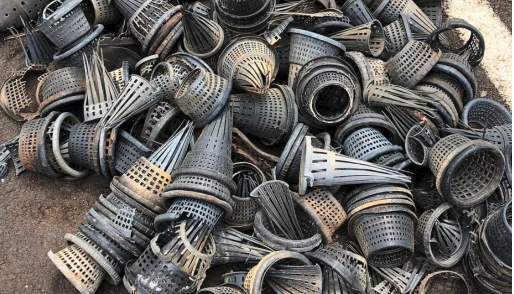Marine debris likely a contributing cause in Kaua'i sperm whale death
 |
 |

Lost and discarded fishing gear is a primary contributor to plastic pollution on Hawaiʻi beaches and poses a major threat to marine and coastal ecosystems. Yet given its international scope, large geographical range, and difficulties in tracing the source of gear, derelict fishing gear remains a challenging problem.
Eel and hagfish traps represent one of the many types of commercial fishing gear that pollute Hawaiʻi coastlines. Compared to other types of fishing gear, however, the eel trap’s distinctive cone shaped funnels are easily identifiable and originate from conger eel fisheries in the East China Sea as well as small hagfish fisheries on the west coast of North America. Conger eels are consumed for food across Asia. The hagfish are sold almost exclusively to Korean markets for food or use in “eel skin” products such as wallets and boots.
There are many different models of traps used in marine eel fisheries along the west coast of North America and in waters off Korea, Japan, Taiwan, and China. Trap entrances are attached to tubes, 5-gallon buckets, or 50-gallon barrels so that eels can enter the trap but not escape. Thousands of the eel trap entrance parts get detached from traps each year, float around in the North Pacific Ocean, and end up on Hawaiian shores. Some are whole and others break apart leaving the cone portion and pieces of plastic on the shore.


In addition, young Hawaiian monk seals can get funnel-like trap parts caught on their snouts, causing abrasion and infection. More importantly they are unable to feed, causing starvation, weakening, and predation by sharks. The monk seals are a highly endangered species, found only in Hawaii, and with only approximately 1,500 individuals remaining. Over the years 2000-2021, 15 seal pups were found entangled in the Northwest Hawaiian Islands and the trap part removed. We must do something to reduce the number of entanglements. We can start by removing eel traps from the beaches before they hurt the pups.

%20(1).jpg?width=500&height=333&name=Hagfish%20trap%20on%20monk%20seal%20DLNR%20(2)%20(1).jpg)
The North Pacific Eel Trap Project is a collaborative effort to develop options aimed at reducing lost and discarded hagfish traps and thus their impact on Hawaiian Monk Seals. It may also serve as a replicable model for future efforts aimed at derelict fishing gear reduction. Since launching the North Pacific Eel Trap project in 2020, Surfrider Foundation and partner organizations from across Hawaiʻi have collected and removed over 10,000 traps from shorelines in both the main Hawaiian islands and the Northwest Hawaiian Islands.
The project's primary goals are:

In 2023, the Kaua'i Chapter received a grant from the Global Ghost Gear Initiative to expand the North Pacific Eel Trap Project to partners in Asia.

If you see an eel trap on the beach, remove it and take photos. Email Surfrider at hagfish@surfrider.org and tell us where/when you found the trap parts. Photos of what you collected, especially photos of the traps looking straight down each cone (see below), would be useful to us in identifying where the cone came from.
How can you help?
Marine debris likely a contributing cause in Kaua'i sperm whale death
 |
 |